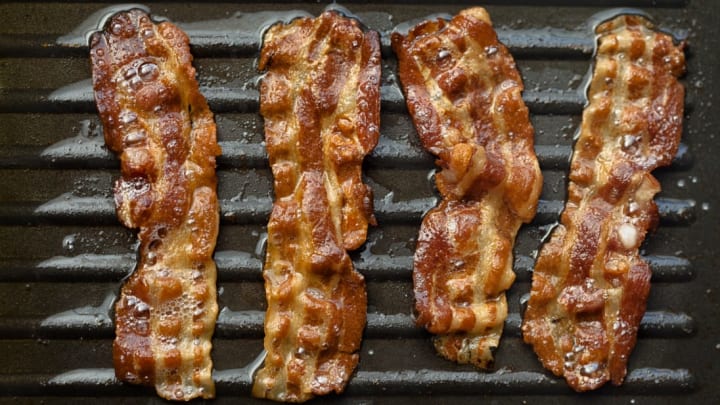Bacon is everywhere these days. You can find it in ice cream, coffee, cupcakes, and chewing gum. There are bacon-scented candles, bacon lip balm, and even a bacon deodorant. With bacon saturating every corner of the market, it’s worth looking at the origins of this smoky, salty food and how it became so wildly popular. In honor of National Bacon Day (December 30th), here are a few facts to whet your appetite.
1. Bacon dates back to 1500 BCE.

The Chinese were the first to cook salted pork bellies more than 3000 years ago. This makes bacon one of the world’s oldest processed meats.
2. Romans called bacon petaso.
Bacon eventually migrated westward, where it became a dish worthy of modern-day foodies. The Romans made petaso, as they called it, by boiling salted pig shoulder with figs, and then seasoning the mixture with pepper sauce. Wine was, of course, a frequent accompaniment.
3. The word bacon refers to the "back" of a pig.

The word bacon comes from the Germanic root “-bak,” and refers to the back of the pig that supplied the meat. Bakko became the French bacco, which the English then adopted around the 12th century, naming the dish bacoun. Back then, the term referred to any pork product, but by the 14th century bacoun referred specifically to the cured meat.
4. The first bacon factory opened in 1770.
For generations, local farmers and butchers made bacon for their local communities. In England, where it became a dietary staple, bacon was typically "dry cured" with salt and then smoked. In the late 18th century, a businessman named John Harris opened the first bacon processing plant in the county of Wiltshire, where he developed a special brining solution for finishing the meat. The "Wiltshire Cure" method is still used today, and is a favorite of bacon lovers who prefer a sweeter, less salty taste.
5. The phrase "bringing home the bacon" dates back centuries.
These days the phrase refers to making money, but its origins have nothing to do with income. In 12th century England, churches would award a flitch, or a side, of bacon to any married man who swore before God that he and his wife had not argued for a year and a day. Men who "brought home the bacon" were seen as exemplary citizens and husbands.
6. Bacon was used to make explosives during World War II.
In addition to planting victory gardens and buying war bonds, households were encouraged to donate their leftover bacon grease to the war effort. Rendered fats created glycerin, which in turn created bombs, gunpowder, and other munitions. A promotional film starring Minnie Mouse and Pluto chided housewives for throwing out more than 2 billion pounds of bacon grease every year: "That’s enough glycerin for 10 billion rapid-fire cannon shells."
7. Hardee's Frisco burger was a game-changer for bacon.
Bacon took a beating in the 1980s, when dieting trends took aim at saturated fats and cholesterol. By the '90s, though, Americans were ready to indulge again. Hardee’s Frisco Burger, one of the first fast-food burgers served with bacon, came out in 1992 and was a hit. It revived bacon as an ingredient, and convinced other fast-food companies to bacon-ize their burgers. Bloomberg called it the Frisco Burger "a momentous event for fast food, and bacon’s fate, in America."
8. The average American consumes 18 pounds of bacon each year.
Savory, salty, and appropriately retro: The past couple of years have been a bonanza for bacon, with more than three quarters of restaurants now serving bacon dishes, and everything from candy canes to gumballs are now flavored with bacon. Recent reports linking processed meats to increased cancer risk have put a dent in consumption, and may have a prolonged effect. But for now, America’s love affair with bacon continues.
9. There's a Church of Bacon.
This officially sanctioned church boasts more than 25,000 members under the commandment "Praise Bacon." It’s more a rallying point for atheists and skeptics than for bacon lovers, per se, and there’s no official location as of yet. But the church does perform wedding ceremonies and fundraisers, and has raised thousands of dollars for charity. All bacon praise is welcome, even if you're partial to vegetarian or turkey bacon over the traditional pork. Hallelujah!
10. There's also a bacon camp.

Bacon camp is like summer camp, but with less canoeing and more bacon cooking. Held every year in Ann Arbor, Michigan, Camp Bacon features speakers, cooking classes, and other bacon-related activities for chefs and enthusiasts eager to learn more about their favorite food.
11. Modern technology wants to help you wake up and smell the bacon.
An ingenious combination of toaster and alarm clock, the Wake 'n Bacon made waves a few years back with the promise of waking up to fresh-cooked bacon. Sadly, the product never made it past the prototype phase, but those intent on rising to that smoky, savory aroma were able to pick up Oscar Mayer’s special app, which came with a scent-emitting attachment.
12. There's a bacon sculpture of Kevin Bacon.

It had to happen eventually. Artist Mike Lahue used seven bottles of bacon bits, lots of glue, and five coats of lacquer to create a bust of the Footloose star, which sold at auction a few years back. No word on how well the bacon bit Bacon bust has held up.
